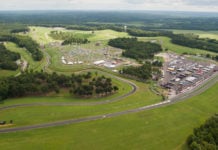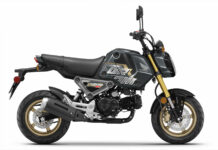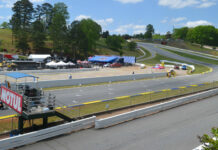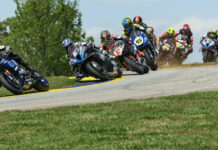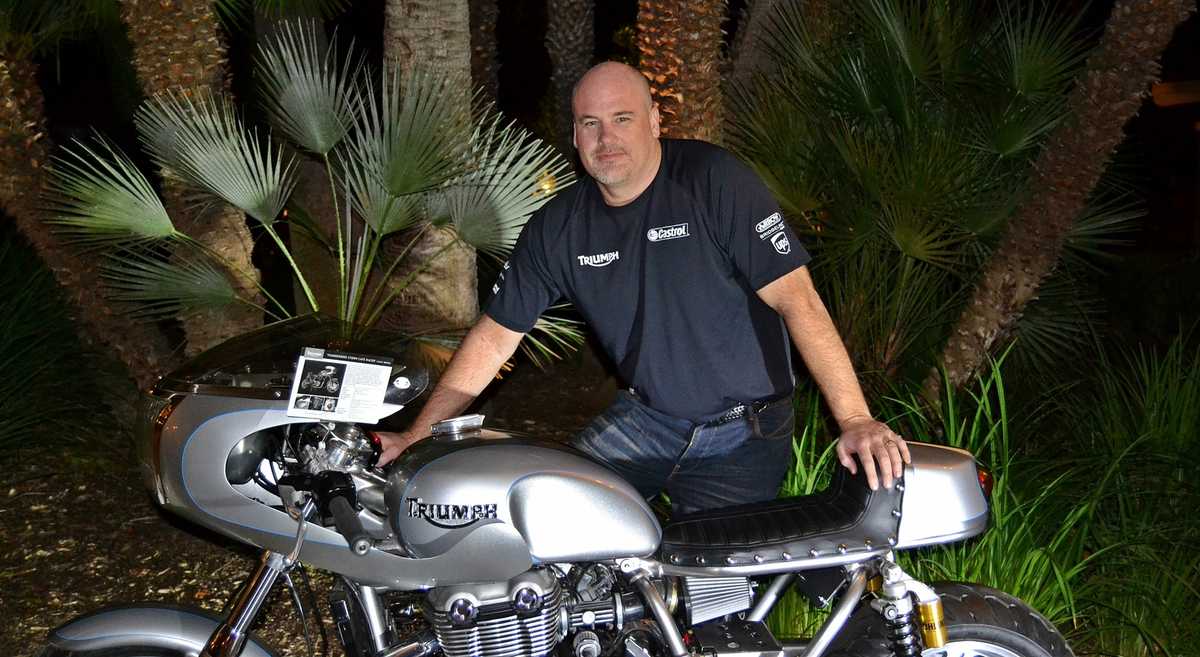Greg Heichelbeck left Harley-Davidson after two decades in sales, strategy and management positions to take the reins of Triumph North America in 2010. Since then, it seems that Triumph has expanded its presence in American racing by the year, with supported teams in AMA Pro Road Racing and several other disciplines. At the AMA Pro Road Racing round at Barber Motorsports Park in June of 2013, the company noted that one-quarter of the Daytona SportBike grid was mounted on the Triumph Daytona 675R Triple.
Racing clearly is important to Triumph. At the recent introduction of the company’s new Thunderbird cruiser and touring twins, Roadracingworld.com had a chance to speak with Heichelbeck about the company, racing, and the role that racing has played in Triumph’s past and its present.
Roadracing World: Tell us about Triumph North America’s racing plans for 2014.
Greg Heichelbeck: “We’ve got a number of racers on our team this year. We’ve expanded. Jason DiSalvo’s back with us–he’s doing the Daytona SportBike series for us, and he’s probably going to do a couple of flat tracks for us, get back into that. And of course he’s going to set the land speed record (Triumph has built a new streamliner powered by a pair of turbocharged Triumph Rocket III engines to seek the world’s fastest motorcycle title once again). To help him out there on the AMA series, we’ve got Bobby Fong. He’s going to be racing and riding with George Latus, our Triumph dealer in Portland. Jason is riding for Apex Manufacturing, which is Sportbike Track Time. Richard Harris is running that program. Elena Myers is also racing for us. She is also going to be racing out of Apex. We’ve added Danny Eslick (on the Riders Discount Triumph team) and we’re added Shayna Texter. Shayna’s going to be doing some flat track for us, and we may–depending on if she’s up for it–get her out on a road course. I know she’s been doing some Sportbike Track Time stuff with Jason. We’re going to have a pretty full complement there.”
RW: Tell us about the relationship between the teams and Triumph.
GH: “They’re not factory teams per se. Richard is the owner of his team, as is George–George has been in this business a long, long time. What we have is a great relationship. George and I worked together when I was at Harley, and he was a Harley dealer, he raced Buells for us–so I had that relationship. Richard–I’ve done business at Sportbike Track Time in the past for Buell, and when he purchased Sportbike Track Time, I developed that relationship. When we decided we wanted to go road racing, George talked to me about it, and I said, ‘Look, I want to get back into it. This is a part of–a deep part of – our heritage. We need to get back into it. I want to do it with someone I have a lot of trust and faith in.’ And so we developed a program that George is comfortable running, because I don’t have the resources to do that, or the people, and I bring some expertise around the bike, parts, my semi–things like that–and he takes care of pretty much everything else. George and Richard pretty much take care of the riders. In Jason’s case, he does a lot more with Triumph, so he has a more direct relationship with us.”
RW: Do the teams have access to the engineers back in Hinckley (home of Triumph motorcycles)?
GH: “Indirectly. They have access to us in North America, our technical guys. Of course, George and Richard have a lot of technical expertise on-site. George has been racing for many, many years, and Richard Harris owns a manufacturing company. He has a great deal of experience in that whole performance side. And then my guys back at the plant provide a lot of support, and if we can’t, then we go back to the factory.”
RW: Why does Triumph go racing?
GH: “It’s our story. It’s who we are. It’s what made us. It’s one of the things that defined us. Racing is just a part of Triumph. We do it to bridge the gap between our past and our future. It’s a nod to history–this is what we did–and we want to make history again. It’s through various forms of racing, the thing that got us noticed in the first place.”
RW: Is there feedback to the factory from racing in terms of the development of parts, development of technology? Does racing provide a test bed for ideas as well?
GH: “Yes. I’m not going to say it’s directly a ‘test bed,’ but a number of pieces of information that we learn on a 675 or even a Bonneville engine, some of the work that Bonneville Performance has done in building their flat tracker, they’ve shared that with us. So racing does provide that–the 675R is a pretty direct link out of that. The last 675, last year’s, that clearly, all that chassis work, came from racing.”
RW: Do you see any other racing platforms in Triumph’s near future?
GH: “We’ll probably do Pikes Peak again. We’re doing land speed record. We’re doing the trike (a Triumph Rocket 3 trike conversion holds a land speed record at more than 133 mph), the 675 with a turbo, the streamliner. There may be some other things. We have a great relationship with Castrol, and Castrol has been supportive of our streamliner. Through that relationship we are cooking up a few more surprises. You may see some more things on the salt, and you may see some more non-traditional things. We’re still developing things. There’s all kinds of racing.”
RW: You have to want to go racing. And clearly Triumph wants to go racing.
GH: “You do. As I’ve said, it’s a big piece of us. We break the brand down along three pillars: The world’s fastest, the world’s greatest, and the world’s coolest. So how’d that happen? The world’s fastest–we know the story (Triumph-powered motorcycles held the land speed record from 1954 to 1970). The world’s greatest–the Gary Nixons, the Gene Romeros, there were all those guys who made it the world’s greatest by winning Daytona, winning the Pikes Peaks, winning the flat track Championships. The coolest came from the Brandos, the Deans, the McQueens.”
RW: So the three pillars work together. And without one…
GH: “Right. They build upon each other. The ‘fastest’ brought the racers, the racers brought the celebrities, the musicians, and the others who wanted to be associated with a cool bike, a fast brand. Nobody wants to say, ‘Hey, I bought the slowest motorcycle!’ That’s not what they say. They say, ‘I bought, either the fastest, or it has this bad-ass paint’–there’s something unique about it. And that was how Triumph was built.”


